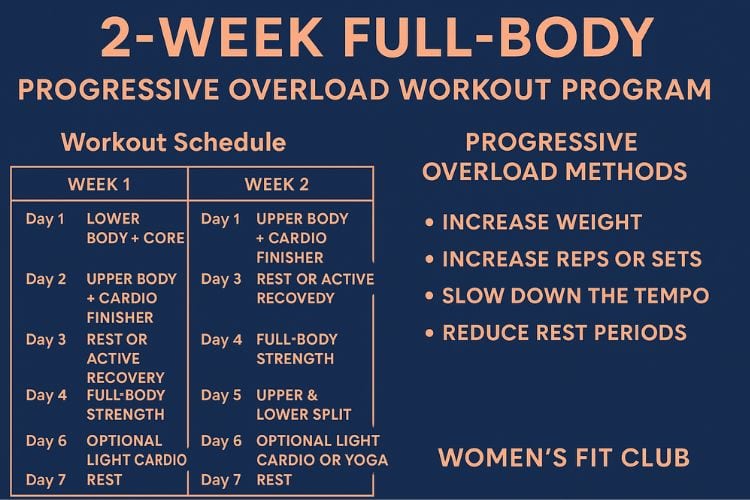Sign up for workout ideas, training advice, reviews of the latest gear and more.






Building strength, toning your body, and improving endurance doesn’t happen overnight — it’s the result of consistent effort and gradual challenge. That’s exactly what this 2-Week Full-Body Progressive Overload Workout Program is designed for. Whether you’re training at home or in the gym, this plan will help you safely increase your strength and muscle tone in just two weeks by using the proven principle of progressive overload.
Progressive overload is the gradual increase of stress placed on your muscles during training. The body adapts to exercise over time, so you must continuously challenge it to keep improving. By progressively increasing the weight, reps, sets, or intensity, your muscles are forced to grow stronger and more defined.
This program targets every major muscle group — legs, chest, back, shoulders, arms, and core — ensuring balanced strength and muscle development. The plan is structured over two weeks with 4 training days per week and active recovery days in between.
Each workout alternates between compound movements (like squats and rows) and isolation exercises (like curls and raises) for full-body balance.
Repeat this structure for Week 2, increasing intensity using progressive overload methods.
Before diving into the workouts, let’s understand the ways you can apply progressive overload during this 2-week plan.
Add 2–5 lbs each week to your lifts if you can maintain proper form.
If you can’t increase weight yet, add one or two extra reps per set or one more set overall.
Slower reps create more time under tension — a great way to intensify without extra weight.
Shortening rest between sets forces your muscles to adapt to higher endurance demands.
Enhancing flexibility and control deepens the challenge of each movement.
This plan is flexible and can be done with:

The first week focuses on form, control, and moderate resistance. You’ll establish a base before increasing intensity next week.
Goal: Strengthen your legs and core while learning to engage your glutes and stabilize your core.
Tip: Focus on slow, controlled movements. Engage your glutes and tighten your core with every rep.
Goal: Strengthen your chest, back, and arms with foundational upper-body moves.
Tip: Maintain a strong core and avoid swinging the weights.
Take a walk, do light yoga, or stretch. Active recovery boosts blood flow and speeds muscle repair.
Goal: Combine upper and lower body exercises for maximum calorie burn and muscle activation.
Tip: Keep intensity moderate but maintain perfect form throughout.
Goal: Mix lower-body strength with upper-body endurance.
Tip: Use a controlled tempo and focus on the muscle being worked.
Do 20–30 minutes of light cardio, cycling, or yoga. This helps recovery while keeping you active.
Take a full rest day. Sleep well, hydrate, and prepare for Week 2 — where intensity goes up.
Now that your body is familiar with the movements, it’s time to challenge yourself with progressive overload. You’ll increase weights, reps, or sets depending on your comfort and form.
Tip: Focus on deep range of motion to engage glutes and hamstrings fully.
Tip: Keep movements controlled, focusing on squeezing muscles at the top of each rep.
Perform 30 minutes of light movement, foam rolling, or yoga to reduce soreness.
Tip: This is your most intense session of the week — focus on controlled power.
Tip: Focus on balance and control — this session enhances stability and sculpting.
Engage in 20–30 minutes of light activity like walking, swimming, or stretching to enhance recovery.
Use this day to rest completely. Reflect on your progress — note the weights lifted, reps improved, and energy levels. Tracking helps you plan your next phase of training.
You’ve completed two weeks of consistent training and applied the foundation of progressive overload. Now you can:
Remember, consistency and progressive challenge are the keys to lasting transformation.
Progressive overload isn’t just about training — it’s also about recovery and fuel.
Aim for 0.8–1g per pound of body weight daily to support muscle repair and growth.
Drink water consistently throughout the day. Even mild dehydration can affect strength performance.
Deep sleep releases growth hormones that repair muscle tissue.
Helps maintain mobility and reduces soreness.
Use a workout log to track weight lifted, reps, and energy levels.
Even in just two weeks, you’ll notice better muscle engagement, improved posture, and higher workout energy.
The 2-Week Full-Body Progressive Overload Workout Program is your gateway to smarter, stronger, and more efficient training. By applying gradual overload principles, you’ll steadily build strength, improve muscle tone, and feel more confident in every workout.
Stay consistent, track your progress, and remember: every rep brings you closer to your goals.
Stay up to date on the latest women’s health, fitness and lifestyle trends and tips.